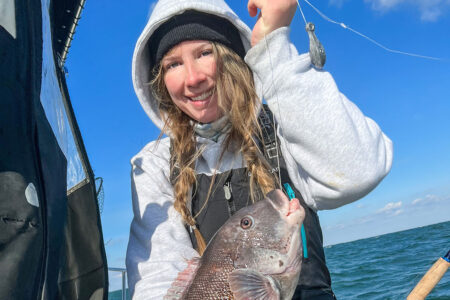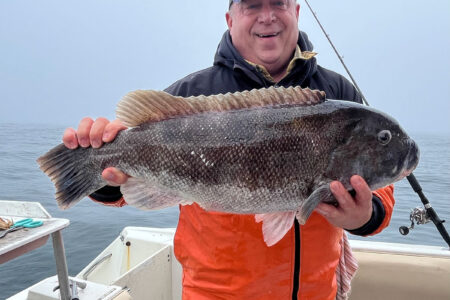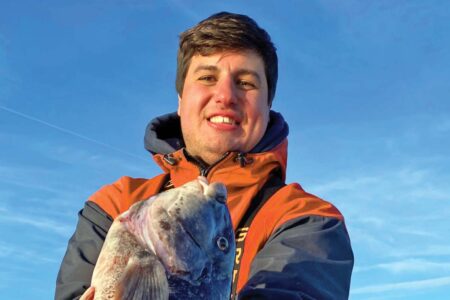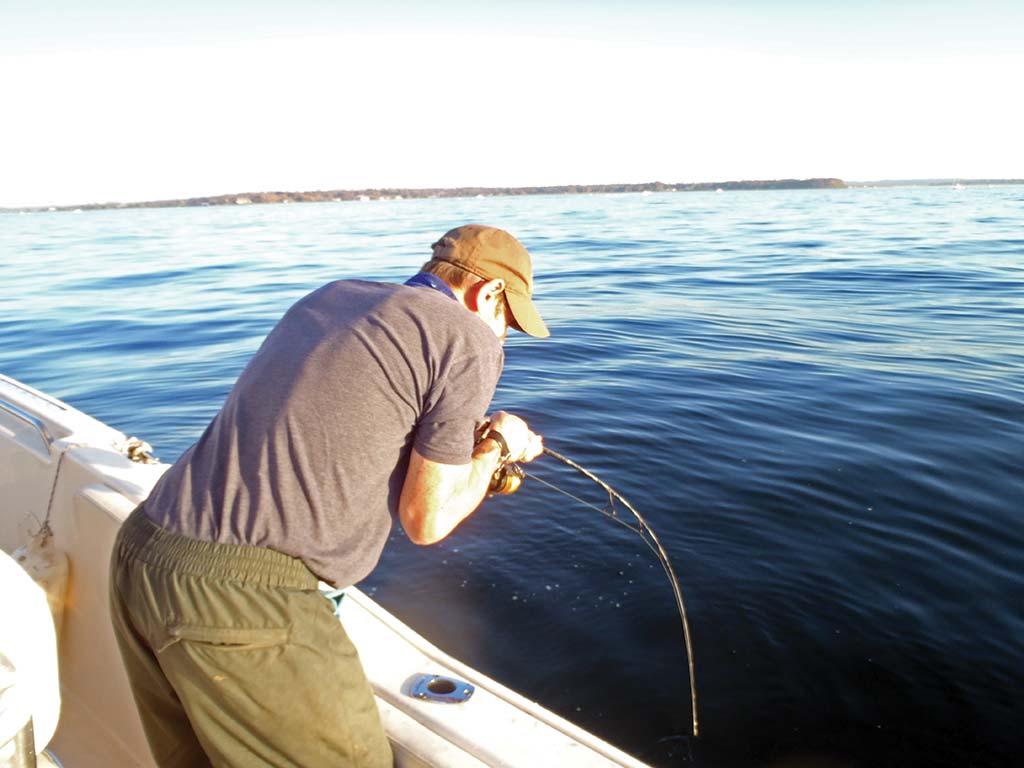
Sooner or later, you’ll get tired of fishing the same overworked bottom spots.
From the extreme western Sound to Orient Point, most anglers gravitate to blackfish spots that other anglers and fishing reports tout highly. Heck, that’s just human nature. However, there is an inherent problem using this approach. True, known spots traditionally produce but, since everyone knows about them, they are often loaded with anchored boats, and the blackfish are heavily pressured. Pressure is an essential consideration because although tog have staged a nice comeback in recent years, there are still a limited number of blackfish on a given piece of bottom, especially in the western Sound. With many hooked baits below, competition among anglers increases sharply while competition among the fish decreases sharply. This is not a good combination.
In addition to competition, timing is also important. In 2020 an excellent two-week run of blackfishing occurred on the Smithtown Reef, but my son and I could not take advantage of it. Many of the legal fish were caught, while others were harassed so much, they left by the time we did.
Far to the west, Rich Lazar and I plied a favored spot. As the tide ebbed, more anglers positioned their boats around us, competition became fierce, and we only caught a few small fish. It was time for a change. Where to go?
Lots Of Choices
There is no shortage of blackfish territory in Long Island Sound. From the Throggs Neck Bridge to Orient Point, the Sound is loaded with rock reefs and boulder fields thanks to the last retreating glacier that deposited them about ten thousand years ago. The Wisconsin Continental Glacier was the last of many during the Ice Age, and it created most of the Sound’s structure. However, all rock piles are not created equal. Rich and I knew that dropping an anchor in a rock field was not a guarantee of success, and therefore we knew we would need to spend time testing locations spot by spot, which was an annoying and arduous task.
We tried spots around Hart Island, Pea Island, Huckleberry Island—you get the idea. Some of the places did produce some small blackfish, while others, similar to where we started, were packed with boats. We needed to find lightly used bottom spots that not only held lots of fish but some big ones, too. I want to say that I helped Rich find a good spot, but I didn’t. No, Rich found a spot while fishing with other local anglers. I’d also like to say that we found several good locations to serve as backup areas if the primary one dried up, but I wouldn’t know that either. The blackfish season is short for estuarine shallow water anglers, so once he found good bottom, we stayed with it.
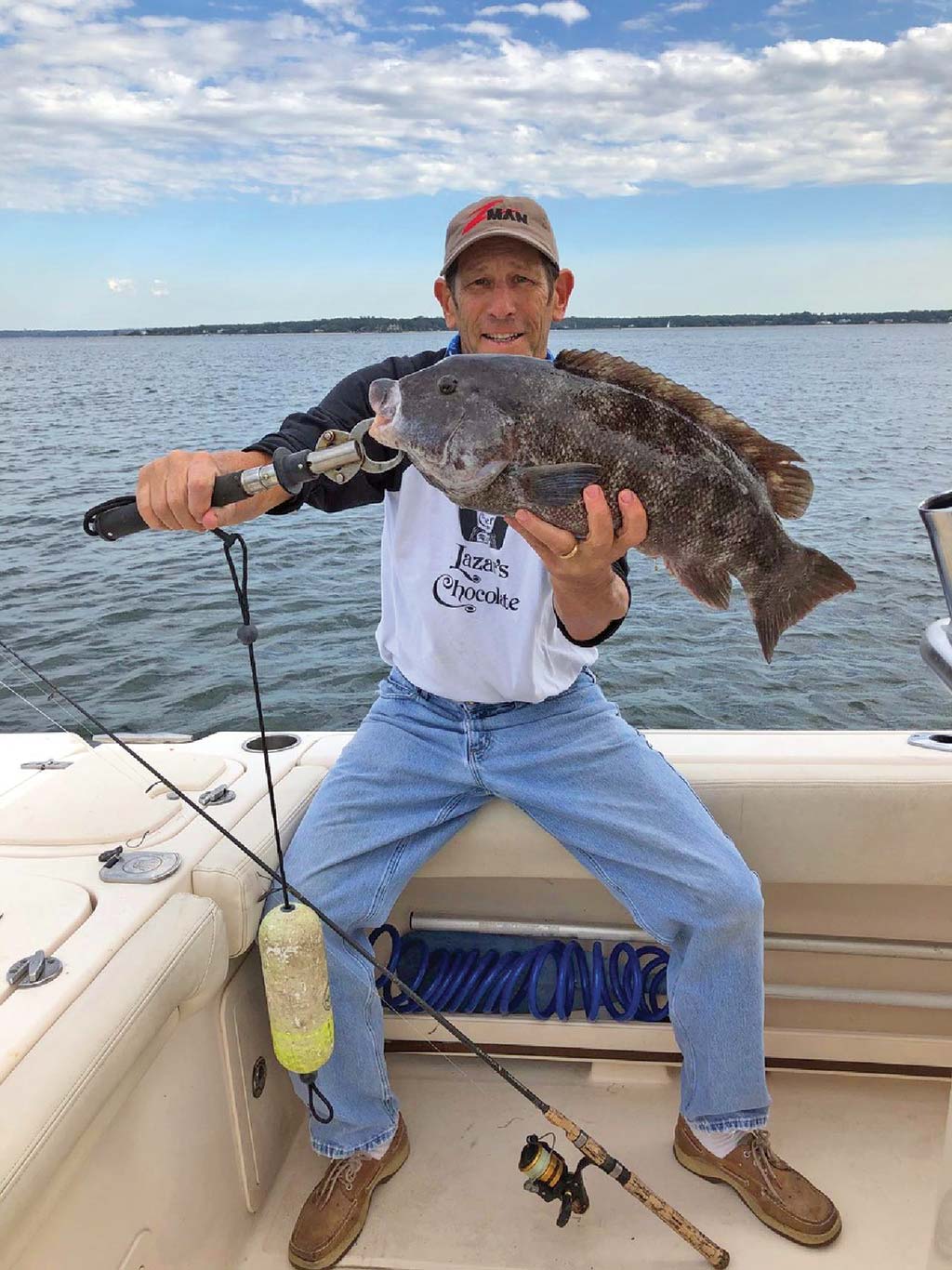
Time Spent Looking
Time spent looking for new bottom becomes a bigger issue the longer it takes to find some. Although there are many potentially good places, happiness is finding a good one quickly—in a matter of a day or two—not weeks. One of the hurdles that anglers need to overcome is the well-accepted idea that blackfish like to move into very shallow structure in the fall. Many sharpies have said to me, “you can’t get too shallow when the bite is on.” Indeed, shallow is the standard, and blackfish are found shallow. Success makes it challenging to change approaches, and we’ve all been well versed in the need to go shallow.
Consider this example. I was fishing with a group of friends out of Port Washington some years ago. We plied rocky areas in about 15 feet of water which is a classic depth for October fishing. We picked away at a few fish and even some keepers, but it was slow going, and the tide had almost run out. Our host told us to reel in because we were going deep into New Rochelle Harbor for one last try in very shallow water. We anchored in only 7-feet of water and began hooking some large blackfish. Seven feet! How about that? So much for the idea that a boat’s engine noise and clanking anchor chases the fish away. If I had any doubt about fall shallow water blackfishing, that experience killed it—at least until Rich Lazar brought me to a deep reef last October. That was his new spot, and we bailed them. We caught over 100 in three hours, and most were 13 to 15 inches, but a dozen or so were four to eight pounds. That was one of the best blackfishing trips I have ever enjoyed and all on light tackle.
Who Knows?
Like all great spots, other anglers will soon discover this one, and soon anchoring space will be at a premium. Maybe they’ll spot us catching fish, or someone else searching for a better spot will find it, too. Possibly that reef won’t produce in 2021. Who knows? However, I do know this—nothing lasts forever. That means sooner or later we’ll have to get on the horse and start searching all over again.
My son Drew and I have had similar experiences in Smithtown Bay. Many spots traditionally hold blackfish, but not all of them every year or in the same quantity. Each year, we find a productive area, but either all the fish are shorts or aren’t on that spot the following year. However, we have learned a few things that should help us to locate blackfish in the future.
We’ve discovered that the amount of bait in an area during a season plays a significant role in how good the blackfishing will be in the fall and which spots will produce better than others—not just the amount of bait in autumn, but the abundance of varied bait species all season, starting with spring sand eels. After decades of accumulating anecdotal evidence, I’ve become convinced that fishing for all species is better when there is a ton of bait from one end of the season to the other. Somehow, high bait productivity seems to make everything work better. Perhaps I gleaned some insight into this idea some years ago. I watched a man introduce small live baitfish into a large tank that held a few blackfish. They swam very fast toward each bait fish, struck vigorously, and inhaled each bait with a single gulp. Although not commonly known, blackfish can be aggressive feeders on small fish.
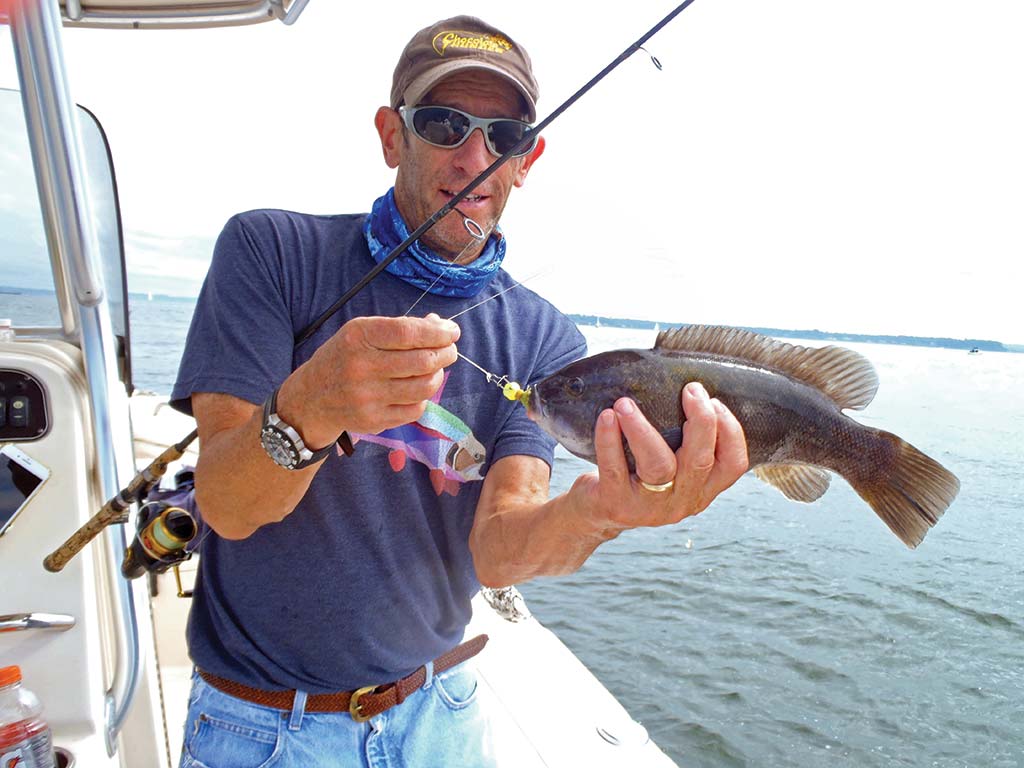
Here’s Why
Putting my experience together with my observations, I think I might understand a little about the relationship between bait abundance and blackfish abundance. It may not make much sense at first, but it does if we look a little closer. Instead of thinking about bottom feeders like porgies, sea bass, and blackfish as separate from other things living in a given marine habitat, look at it this way. Since bottom feeders, including blackfish, are part of an ecosystem, it stands to reason that they affect other critters and other critters affect them. If there’s lots of bait through the season, then productivity is high. Not only does the bait attract more predators, but there’s also more leftovers. Bait, like everything else, not only dies of predation, but old age, parasites, and microbial diseases, too. The dead stuff, including some predators, means there is more for the scavengers such as worms, shrimp, crabs, and even some mollusk species to feed on, and those species increase in number. Guess who eats all of that stuff? Right, bottom feeders such as blackfish.
I have written many times about the importance of lots of bait during the early, middle, and late season. In healthy systems, an abundance of all little living things ultimately translates into abundant bigger things because all life is linked together. Indeed, managers are gradually switching from single-species management to an ecosystem approach. The idea of species overlap is also crucial as we reflect on our role as harvesters in the ecosystem.
Getting Started
Finding your own bottom takes time and perseverance, as already mentioned, so it’s helpful if an angler can jump-start the process. First, it helps to know your backyard blackfish grounds. If you’re new to the sport, consider a charter, or jump on a local party boat and then note where you go, the bottom depth, and the tide stage. If you’re lucky, a friend might take you out to one of their spots, and you can pick up valuable knowledge that way. Second, get a detailed chart of your local waters. Today’s charts are large, accurate, and easy to read, laminated to protect against the elements, fish slime, and bait goo. Third, use that chart to plan a day’s drops. Fourth, select spots with some current but not strong currents: they seem to produce best. Fifth, be methodical and work an area thoroughly before coming to a good or bad opinion about the spot. Fifteen minutes on a location is too short, and an hour is too long. We find that typically the fish don’t bite right away, but if they are there, the smell of your baits will bring them to you in about a half-hour or less. Sixth, bring lots of good bait. By that, I mean fresh, lively crabs and freshly shucked clams. Rotting bait will catch some fish, but fresh stuff exudes more of the right juices to pull them to you. Decades ago, a half-bushel of green crabs would be enough for two anglers for a good part of the tide. However, green crabs were much larger then, and almost all could be quartered. Many more green crabs go to market today, so most are captured before they are fully grown. Today, we only get two pieces from most crabs, and many of them are so small they must be used one to a hook. So, I think two anglers need at least six dozen crabs for a trip. Seventh, we also bring along some clams for two reasons. One, the non-muscle parts are thrown over for chum, and two, we have backup bait if we run out of crabs. There are days when blackfish aren’t thrilled with the clams, but they also outfish the crabs on occasion. We don’t even bother with Asian crabs anymore because we’ve generally found little difference between the greens and Asians.
Consider It An Adventure
Sooner or later, you’ll get tired of fishing the same overworked bottom spots, and you’ll begin to think about exploring new potentially productive grounds. As I said, there are many potential spots, so you’re not looking for a needle in a haystack. Consider it to be an adventure—new grounds, new sights, new ideas. It doesn’t hurt that when you find a good one, you may experience the best blackfishing of your life.

